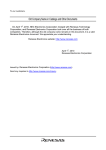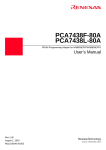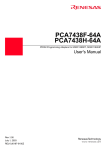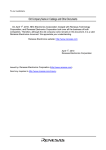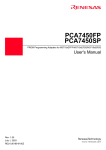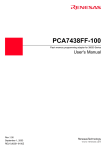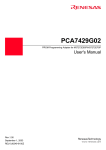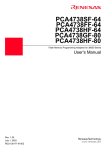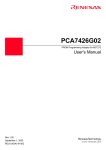Download Renesas PROM Programming Adapter PCA7447FP User`s manual
Transcript
PCA7447FP PROM Programming Adapter for M38C89EFFP User's Manual Rev.1.00 September 1, 2003 REJ10J0253-0100Z • R4945 and R4945A are trademarks of Advantest Corporation. Keep safety first in your circuit designs! • Renesas Technology Corporation and Renesas Solutions Corporation put the maximum effort into making semiconductor products better and more reliable, but there is always the possibility that trouble may occur with them. Trouble with semiconductors may lead to personal injury, fire or property damage. Remember to give due consideration to safety when making your circuit designs, with appropriate measures such as (i) placement of substitutive, auxiliary circuits, (ii) use of nonflammable material or (iii) prevention against any malfunction or mishap. Notes regarding these materials • These materials are intended as a reference to assist our customers in the selection of the Renesas Technology product best suited to the customer's application; they do not convey any license under any intellectual property rights, or any other rights, belonging to Renesas Technology Corporation, Renesas Solutions Corporation or a third party. • Renesas Technology Corporation and Renesas Solutions Corporation assume no responsibility for any damage, or infringement of any third-party's rights, originating in the use of any product data, diagrams, charts, programs, algorithms, or circuit application examples contained in these materials. • All information contained in these materials, including product data, diagrams, charts, programs and algorithms represents information on products at the time of publication of these materials, and are subject to change by Renesas Technology Corporation and Renesas Solutions Corporation without notice due to product improvements or other reasons. It is therefore recommended that customers contact Renesas Technology Corporation, Renesas Solutions Corporation or an authorized Renesas Technology product distributor for the latest product information before purchasing a product listed herein. The information described here may contain technical inaccuracies or typographical errors. Renesas Technology Corporation and Renesas Solutions Corporation assume no responsibility for any damage, liability, or other loss rising from these inaccuracies or errors. Please also pay attention to information published by Renesas Technology Corporation and Renesas Solutions Corporation by various means, including the Renesas home page (http://www.renesas.com). • When using any or all of the information contained in these materials, including product data, diagrams, charts, programs, and algorithms, please be sure to evaluate all information as a total system before making a final decision on the applicability of the information and products. Renesas Technology Corporation and Renesas Solutions Corporation assume no responsibility for any damage, liability or other loss resulting from the information contained herein. • Renesas Technology semiconductors are not designed or manufactured for use in a device or system that is used under circumstances in which human life is potentially at stake. Please contact Renesas Technology Corporation, Renesas Solutions Corporation or an authorized Renesas Technology product distributor when considering the use of a product contained herein for any specific purposes, such as apparatus or systems for transportation, vehicular, medical, aerospace, nuclear, or undersea repeater use. • The prior written approval of Renesas Technology Corporation and Renesas Solutions Corporation is necessary to reprint or reproduce in whole or in part these materials. • If these products or technologies are subject to the Japanese export control restrictions, they must be exported under a license from the Japanese government and cannot be imported into a country other than the approved destination. Any diversion or reexport contrary to the export control laws and regulations of Japan and/or the country of destination is prohibited. • Please contact Renesas Technology Corporation or Renesas Solutions Corporation for further details on these materials or the products contained therein. Precautions to be taken when using this product • This product is a development supporting unit for use in your program development and evaluation stages. In mass-producing your program you have finished developing, be sure to make a judgment on your own risk that it can be put to practical use by performing integration test, evaluation, or some experiment else. • In no event shall Renesas Solutions Corporation be liable for any consequence arising from the use of this product. • Renesas Solutions Corporation strives to renovate or provide a workaround for product malfunction at some charge or without charge. However, this does not necessarily mean that Renesas Solutions Corporation guarantees the renovation or the provision under any circumstances. • This product has been developed by assuming its use for program development and evaluation in laboratories. Therefore, it does not fall under the application of Electrical Appliance and Material Safety Law and protection against electromagnetic interference when used in Japan. Renesas Tools Homepage http://www.renesas.com/en/tools ( 2 / 18 ) Contents Chapter 1. Precautions for Safety ........................................................................................... 4 1.1 Safety Symbols and Meanings .............................................................................. 4 Chapter 2. Introduction ........................................................................................................... 6 2.1 Things to Check When Unpacking ....................................................................... 6 Chapter 3. Specifications ........................................................................................................ 7 Chapter 4. How to Write the Program .................................................................................... 8 4.1 Programming Procedure ........................................................................................ 8 4.2 Attaching Adapter to PROM Programmer ............................................................ 9 4.3 Inserting MCU into Adapter ............................................................................... 10 4.4 Precautions When Opening and Closing the IC Socket ...................................... 11 4.5 Caution to Be Taken for This Product ................................................................ 11 4.6 Setting a Programming Area ............................................................................... 11 Chapter 5. Recommended PROM Programmers .................................................................. 12 Chapter 6. Memory Maps ..................................................................................................... 13 Chapter 7. Troubleshooting .................................................................................................. 14 7.1 Errors That Occur When Writing to PROM ....................................................... 14 7.1.1 When Newly Purchased ........................................................................ 14 7.1.2 Previously Written Normally ................................................................ 14 7.2 MCUs Do Not Function Normally ...................................................................... 15 7.3 Other Precautions ................................................................................................ 15 7.3.1 About the Recommended PROM Programmers ................................... 15 7.3.2 About Reading Out of Device Identification Code .............................. 15 7.4 How to Request for Support ................................................................................ 15 To use the product properly Precautions for Safety: • Both in this User's Manual and on the product itself, several icons are used to insure proper handling of this product and also to prevent injuries to you or other persons, or damage to your properties. • The icons' graphic images and meanings are given in "Chapter 1. Precautions for Safety" (page 4). Be sure to read this chapter before using the product. ( 3 / 18 ) Chapter 1. Precautions for Safety In both the user's manual and on the product itself, several icons are used to insure proper handling of this product and also to prevent injuries to you or other persons, or damage to your properties. This chapter describes the precautions which should be taken in order to use this product safely and properly. Be sure to read this chapter before using this product. 1.1 Safety Symbols and Meanings WARNING If the requirements shown in the "WARNING" sentences are ignored, the equipment may cause serious personal injury or death. CAUTION If the requirements shown in the "CAUTION" sentences are ignored, the equipment may malfunction. IMPORTANT It means important information on using this product. In addition to the three above, the following are also used as appropriate. means WARNING or CAUTION. Example: CAUTION AGAINST AN ELECTRIC SHOCK means PROHIBITION. Example: DISASSEMBLY PROHIBITED means A FORCIBLE ACTION. Example: UNPLUG THE POWER CABLE FROM THE RECEPTACLE. The following pages describe the symbols "WARNING", "CAUTION", and "IMPORTANT". ( 4 / 18 ) WARNING Warnings for Use Environment: • This equipment is to be used in an environment with a maximum ambient temperature of 35˚C. Care should be taken that this temperature is not exceeded. • Select the proper programming mode of the PROM programmer. CAUTION Cautions to Be Taken for This Product: • Do not disassemble or modify this product. Disassembling or modifying this product can cause damage. Disassembling and modifying the product will void your warranty. • Use caution when handling this product. Be careful not to apply a mechanical shock such as falling. • Do not directly touch the connector pins of this product. • Be careful with the static electricity when handling this product and the MCU. Caution for Keeping This Product: • When not using this product for a long time: (1) Attach the connector pins of this product to the conductive sponge. (2) Put it into a conductive polyvinyl, and keep it in the package case shipped from the factory. (3) Store it in the place where humidity and temperature are low and direct sunshine does not strike. IMPORTANT When Using The Product: • Attach this product to the IC socket on the PROM programmer properly. • Insert the MCU to the IC socket of this product properly. • When inserting and pulling out the MCU, be sure to keep the IC socket side above and horizontal. • Be sure to set the programming area according to your PROM programmer. • Do not use the PROM programmer's device identification code readout function. ( 5 / 18 ) Chapter 2. Introduction The PCA7447FP is a PROM programming adapter for M38C89EFFP (8-bit MCU). The PCA7447FP is used to write programs into the internal EPROM of MCU with commercially available PROM programmer. This manual mainly explains specifications of PCA7447FP and how to operate it. Figure 2.1 shows the external view of the product and its constituent parts. Figure 2.1 External view of adapter and constituent parts (IC socket: QFP) 2.1 Things to Check When Unpacking This product consists of the parts listed in Table 2.1. When unpacking, check to see that it contains all of the components. Table 2.1 Package components Main unit PCA7447FP Interface unit PCA7402B Connector PCA7402E (32-pin) User's manual This manual * If any part is missing or there is any doubt about your product package, contact your local distributor. ( 6 / 18 ) Chapter 3. Specifications Table 3.1 lists specifications of the programming adapters. Table 3.1 Specifications Operating clock frequency Power supply PCA7447FP (Main unit) Board configuration PCA7402B (Interface unit) PCA7402E (Connector) 1MHz (Supplied by the ceramic oscillator mounted on the adapter) Supplied from Vcc of the PROM programmer Board to insert a programmable MCU (IC socket mounted on it) Interface board (Connected by two rows of standard-pitch 18-pin connectors and two rows of standard-pitch 16-pin connectors to the upper and lower boards) Board to connect to the PROM programmer (Standard-pitch 32-pin pin-header mounted) ( 7 / 18 ) Chapter 4. How to Write the Program This chapter describes procedures you need to follow when writing the program. For details on how to operate the PROM programmer, refer to the user's manual of the PROM programmer. 4.1 Programming Procedure Follow steps (1) to (7) below to write the program. (1) Read the program into the PROM programmer. (2) Attach the adapter to the IC socket of the PROM programmer. See "4.2 Attaching Adapter to PROM Programmer" (page 9). (3) Insert the MCU into the adapter. See "4.3 Inserting MCU into Adapter" (page 10). (4) Set the programming area with the PROM programmer.*1 See "4.6 Setting a Programming Area" (page 11). (5) Check to erase the programming area.*2 Using the PROM programmer's erase check function, check whether data can be written into the MCU's programming area. (6) Write the program into the programming area of the MCU using the PROM programmer.*2 (7) Verify the programming area of the MCU using the PROM programmer to check whether the program has been written into the MCU correctly.*2 *1 Be sure to set the programming area. Otherwise the mode's shift to the programming mode may not be performed successfully. The erase check function and others may not also be performed completely. *2 Some PROM programmers perform the steps (5) to (7) automatically. ( 8 / 18 ) 4.2 Attaching Adapter to PROM Programmer As shown in Figure 4.1, attach the No. 1 pin of the PCA7402E connector (standard-pitch 32-pin pinheader mounted) to the No. 1 pin of the IC socket of the PROM programmer. Be careful when attaching to the PROM programmer because incorrect insertion can cause fatal damage to the MCU. Figure 4.1 Attaching adapter to PROM programmer ( 9 / 18 ) 4.3 Inserting MCU into Adapter As shown in Figure 4.2, insert the MCU into the IC socket with the No. 1 pin of the MCU matched to the No. 1 pin of the IC socket on the PCA7447FP. Be careful when attaching to the PROM programmer because incorrect insertion can cause fatal damage to the MCU. Top view Figure 4.2 Inserting an MCU (IC socket: QFP) ( 10 / 18 ) 4.4 Precautions When Opening and Closing the IC Socket When opening and closing the IC socket, keep the IC socket side above and horizontal. Otherwise the inside of the IC socket may become damaged and cause an electrical insulation failure. Figure 4.3 shows the state of opening and closing the IC socket to insert the MCU. Side view Figure 4.3 Opening and closing the IC socket and inserting MCU 4.5 Caution to Be Taken for This Product Do not touch the connector in the IC socket and the pins on the PROM programmer connector because dirt may cause an electrical insulation failure. When not using this product, attach the connector pins of this product to the conductive sponge as it was shipped from the factory. 4.6 Setting a Programming Area When writing and erasing programs, be sure to set the programming area. And also, specify its device of the PROM programmer. Table 4.1 Programming area PROM programmer MCU M38C89EFFP ROM size 60KB Device Programming area M5M27C101 0108016 - 0FFFD16 ( 11 / 18 ) Internal memory area of MCU 108016 - FFFD16 Chapter 5. Recommended PROM Programmers The PROM programmers listed in Table 5.1 are recommended for this product. Using the actual products, we have verified that these PROM programmers can be used to write programs without problem. Nonconformity occurring by using any other PROM programmers can not be supported. For the latest type of PROM programmers, contact the manufacturer to confirm whether it can be used for your product. Table 5.1 Recommended PROM programmers Manufacturer Type name Device Programming voltage (Vpp) M5M27C101 mode 12.5V R4945 Advantest Corporation R4945A ( 12 / 18 ) Chapter 6. Memory Maps Figure 6.1 shows memory maps of the MCU and the PROM programmer. 000016 0000016 Unused area 100016 107F16 108016 Reserved ROM area Internal memory area (60K bytes) FFFD16 FFFE16 FFFF16 Reserved ROM area 0107F16 0108016 Programming area Unused area 0FFFD16 0FFFE16 0FFFF16 1000016 Unused area 1FFFF16 MCU PROM programmer (M5M27C101 mode) Figure 6.1 Memory maps ( 13 / 18 ) Chapter 7. Troubleshooting The table below summarizes errors to be checked carefully before you determine them to be a fault. 7.1 Errors That Occur When Writing to PROM 7.1.1 When Newly Purchased Cause Remedy See page 9 Programming adapter Is the adapter attached to the correct position of the PROM programmer? Is the MCU attached to the correct position? 10 Is the area specification set correctly? 11 Is the correct device selected? 12 PROM programmer The IC socket of the PROM programmer may be stained. The socket needs replacing. - Cause Remedy See page Is the adapter attached to the correct position of the PROM programmer? 9 Programming adapter Is the MCU attached to the correct position? 10 Is the area specification set correctly? 11 Is the correct device selected? 12 Contact failure 7.1.2 Previously Written Normally PROM programmer Contact failure The IC socket of the PROM programmer may be stained. The socket needs replacing. - The PROM programmer connector at which the PROM programmer is contacted may be stained. Clean it with alcohol, etc. - ( 14 / 18 ) 7.2 MCUs Do Not Function Normally The program operates normally on the emulator, but when the MCU that has normally been written is attached the same program does not function normally. (1) Is the offset address specified correctly when copying data into the PROM programmer? (2) In the emulator, NOPs are often inserted in the area where the program has not been read, therefore the program happens to appear functioning normally even though it may have gone wild. Check your program again. (3) The emulator and the actual MCU may differ in characteristics. Consult the user's manual of the emulation pod to check for differences in characteristics again. 7.3 Other Precautions 7.3.1 About the Recommended PROM Programmers Not all PROM programmers available on the market can be checked to see if they function properly. There are several PROM programmers that we have verified to function properly. These products are listed as recommended PROM programmers in this user's manual. Other PROM programmers may also be used providing that you verified them to function properly. Note: No matter which type of PROM programmer you use, it is necessary to verify completion of programming by executing screening, etc. that are stipulated for each MCU used. 7.3.2 About Reading Out of Device Identification Code *1 Please do not use the PROM programmer's device identification code readout function. Using this function may break down the MCU. The device identification code is included in EPROM to indicate the manufacturer code and device code; it is not included in the MCU. *1 Depending on PROM programmer manufacturers, this may be referred to by another name (e.g. ID code). 7.4 How to Request for Support After checking this manual, fill in the following information and email to your local distributor. For prompt response, please specify the following information: (1) Contact address • Company name • Department • Responsible person • Phone number • Fax number • E-mail address (2) Product information • Name of the programming adapter • Serial number • Date of purchase • Target MCU • Symptoms (Fails blank check/Cannot write a program/Fails verification etc.) • Detailed symptoms • How often does the problem occur? (2 out of 10 etc.) • When did the problem start to occur? (Since purchase/Used to work correctly) • Type name of the PROM programmer (Advantest R4945A etc.) • Specified device when writing to PROM (M27C101 etc.) • Specified programming area when writing to PROM • Switch settings of the adapter when writing to PROM ( 15 / 18 ) MEMO ( 16 / 18 ) PCA7447FP User's Manual Rev.1.00 September 1, 2003 REJ10J0253-0100Z COPYRIGHT ©2003 RENESAS TECHNOLOGY CORPORATION AND RENESAS SOLUTIONS CORPORATION ALL RIGHTS RESERVED


















